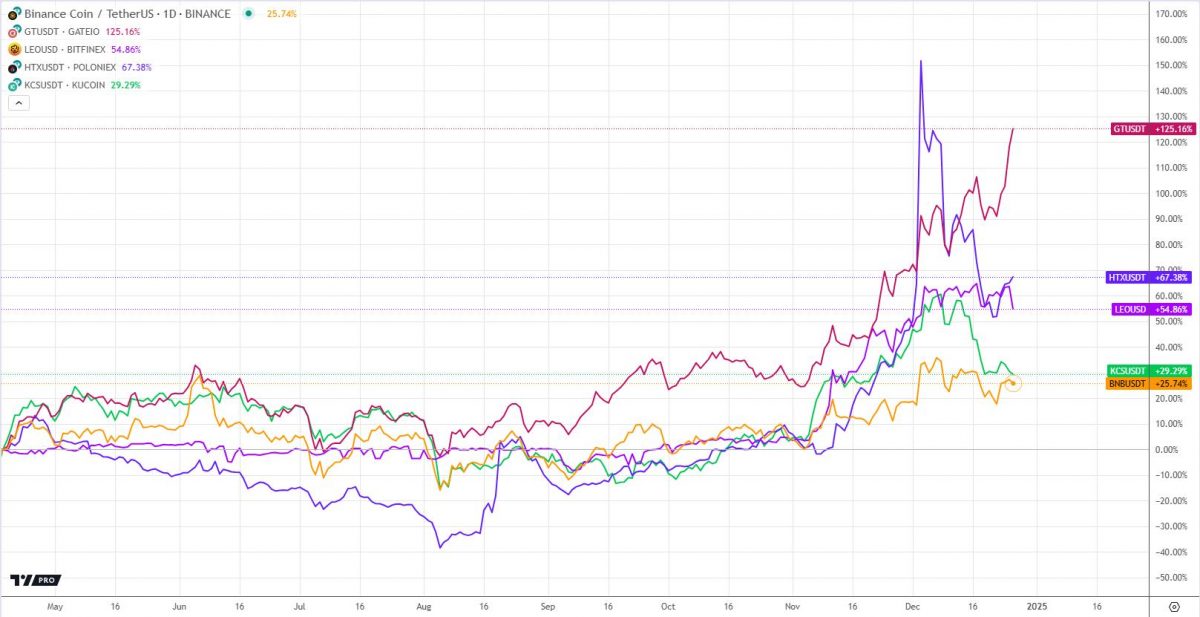With each price surge, the cryptocurrency market continues to attract global investors, and large crypto exchanges play an essential role in this dynamic landscape. A key aspect of these exchanges is the availability of their tokens, which offer users certain benefits. It’s important to understand how these tokens work and weigh their pros and cons when trading. Observing market trends, such as those shown in the Ethereum price chart, can also provide valuable insights for investors navigating the volatile cryptocurrency market.
1. Binance
- Coin: Binance Coin (BNB)
Advantages:
- Versatility: BNB, unlike Bitcoin, can be used to pay trading fees on the exchange, allowing users to save up to 25% of commissions.
- Token burn strategy: Binance regularly burns BNB, creating a scarcity of tokens that could potentially increase its value.
- Binance ecosystem: BNB is actively used across various Binance products such as Binance Smart Chain and Binance Launchpad.
Disadvantages:
- Regulatory risks: Binance faces regulatory challenges in multiple countries, which could ompact its operations and BNB.
- Competition: New DeFi projects are emerging, offering similar or more appealing features.
2. Gate.io
- Coin: GateToken (GT)
Advantages:
- Exclusive benefits: GT holders enjoy perks like reduced trading fees and higher withdrawal limits.
- Diverse projects:io actively supports new tokens and token sales, making it a platform for early investors.
Disadvantages:
- Low liquidity: Compared to larger exchanges, Gate.io may have fewer active trading pairs, which affects trading volume.
- Reputation: The platform has faced criticism over transparency concerns.
3. Bitfinex
- Coin: LEO Token (LEO)
Advantages:
- Fee discounts: LEO holders enjoy discounts on trading fees, making it attractive to frequent traders.
- Wide crypto support: Bitfinex offers a broad range cryptocurrencies and derivatives.
Disadvantages:
- Negative reputation: Bitfinex has been involved in several scandals, which could undermine users’ trust.
- Regulatory hurdles: Strict regulatory requirements in certain jurisdictions limit its operations.
4. HTX
- Coin: HTX Token (HTX)
Advantages:
- Loyalty programs: HT holders get various bonuses and discounts.
- Investment opportunities: Huobi is actively developing products for institutional investors and DeFi enthusiasts.
Disadvantages:
- Rule changes: The exchange frequently adjusts its programs and terms for HT holders, which could lead to user dissatisfaction.
- Competition: Huobi faces strong competition from other major platforms in the markets.
5. KuCoin
- Coin: KuCoin Shares (KCS)
Advantages:
- Dividends: KCS holders earn commission distributions, providing a source of passive income.
- Variety of tokens: KuCoin offers a range of lesser-known, promising altcoins that may appeal to traders.
Disadvantages:
Liquidity issues: Lower trading volumes for some pairs could affect order execution.
Regulatory risks: KuCoin is also facing scrutiny from regulators in various countries.

Comparison of market capitalization and network features
BNB is currently one of the most capitalized coins, with a market value exceeding $30 billion. In comparison, GT, LEO, HTX, and KCS have much smaller market caps, ranging from $200 million to $1 billion.
Each platform has its unique network, with Binance and HTX standing out due to their ecosystems and active involvement with DeFi projects. Bitfinex, on the other hand, is focused on creating a platform for derivatives and institutional investors.
The choice of a crypto exchange and its token depends on users’ preferences and trading goals. Binance and HTX excel with their functionality and high trading volumes, while platforms like KuCoin and Gate.io cater to more niche markets with unique offerings. Investors should carefully evaluate the advantages and disadvantages of each platform to make informed financial decisions.

Disclaimer: The views expressed in this article are those of the author and may not reflect the views of the CryptoTotem team. This article is for informational purposes only and is not intended to be used as legal, tax, investment or financial advice. The author or the publication does not hold any responsibility, directly, or indirectly, for any damage or loss caused or alleged to be caused by or connected with the use of or reliance on any content, goods or services mentioned in this article. Readers should do their own research before taking any action on this matter.






